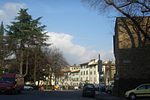Porta San Frediano
Gates of Florence

The Porta San Frediano was the westernmost gate in the 13th-century walls of the Oltrarno section of Florence, region of Tuscany, Italy. It is located where Borgo San Frediano becomes Via Pisana. This was the access gate to the road to Pisa.
Excerpt from the Wikipedia article Porta San Frediano (License: CC BY-SA 3.0, Authors, Images).Porta San Frediano
Via Pisana, Florence Quartiere 4
Geographical coordinates (GPS) Address Nearby Places Show on map
Geographical coordinates (GPS)
| Latitude | Longitude |
|---|---|
| N 43.770466666667 ° | E 11.240005555556 ° |
Address
Via Pisana 6
50123 Florence, Quartiere 4
Tuscany, Italy
Open on Google Maps










